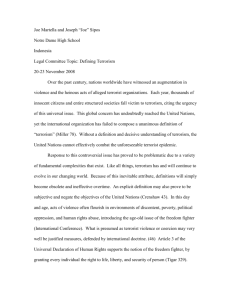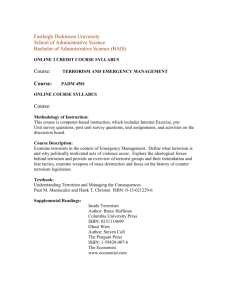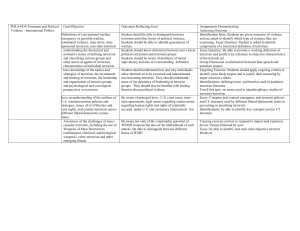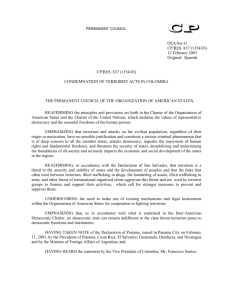Mapping Terrorist Organizations
advertisement
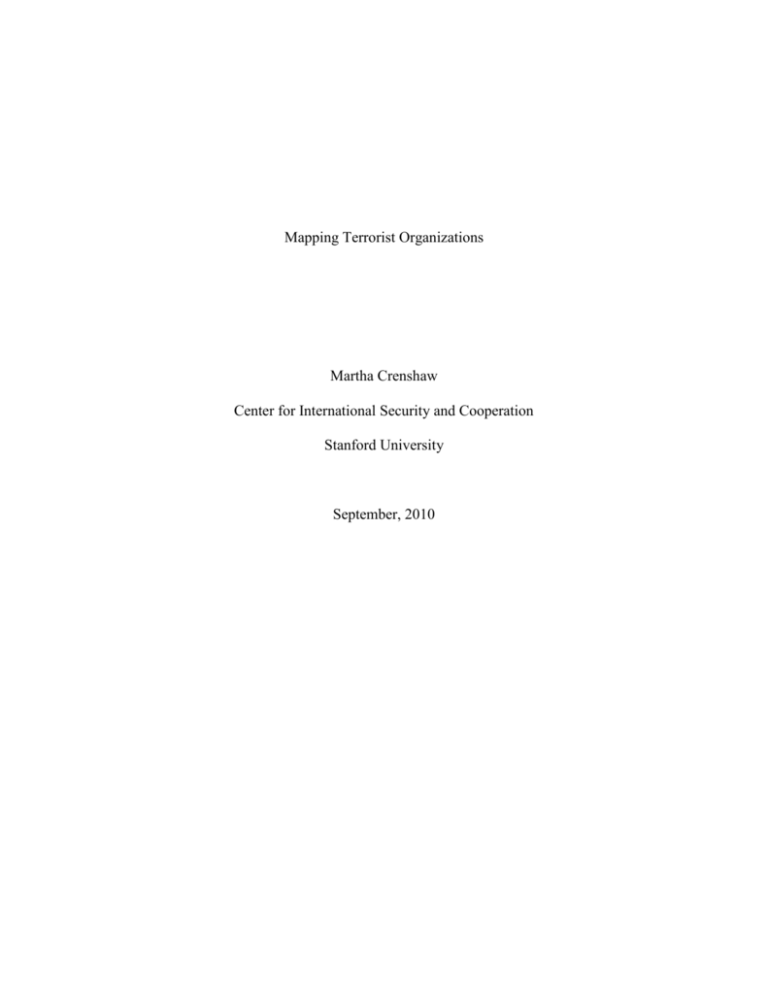
Mapping Terrorist Organizations Martha Crenshaw Center for International Security and Cooperation Stanford University September, 2010 Introduction The purpose of this research project is to identify patterns in the evolution of terrorist organizations, specify their causes and consequences, and analyze the development of Al Qaeda and its cohort in a comprehensive comparative framework.1 It is funded by the National Science Foundation as part of the Department of Defense Minerva Initiative for a three-year period (2009-2012). My purpose is to analyze the organizational structure of families of terrorist organizations and trace their relationships over time. The foundation for building theoretical explanations includes a database of terrorist organizations (as well as those involved in interactions with them) and a series of dynamic maps of the architecture of violent and non-violent opposition groups existing in the same social movement sector or conflict system. I intend to identify distinct patterns of organizational evolution, as groups form, split, merge, collaborate, compete, shift ideological direction, adopt or renounce terrorism, grow, shrink, and eventually decline over time. The project selects cases where multiple oppositional groups, both terrorist and non-terrorist, interact with other and the government over an extended period of time. The groups are seen as actors in conflict systems that can range from simple to complex. The project also develops computer software to assemble, organize, and display information about organizations and their interactions as they change over time. No such study exists in the literature on terrorism or other forms of oppositional violence. There are excellent studies of individual groups or categories of groups (case The term “terrorist organizations” can be controversial. I am referring to non-state actors opposing government authority through the use of terrorism, a form of violence that does not aim to defeat the government’s military or security forces but to influence popular attitudes. My use of the term is not meant to imply that such organizations only use terrorism. 1 1 histories or organizational analyses such as social network theory and the club model) and some comparative studies (e.g., of how terrorism ends or processes of terrorism). A few databases list groups and provide some identifying attributes, but they are not comprehensive, and there is no overarching theory of relationships among groups over time. Evolutionary mapping enhances our understanding of how terrorist groups develop and interact with each other and with the government, how strategies of violence and non-violence are related, why groups persist or disappear, and how opportunities and constraints in the environment change organizational behavior over time. Attempts to explain terrorism in terms of macro-level conditions such as poverty, democracy, or foreign military occupation miss the significance of the independent decision-making capacity of sub-state actors. Focusing on terrorist organizations in isolation addresses the issue of agency but misses the significance of interactions. The central problem is to explain the evolution of terrorist organizations as they interact with each other, with other political actors, and with the government. This project identifies patterns in the development of families or clusters of terrorist organizations, asks what explains these patterns of relationships, and asks in turn what these patterns explain. Research Objectives I anticipate findings in the following areas: (1) Defining common patterns in the architecture of terrorism. Identification of patterns is based on a series of dynamic maps focusing on groups as they evolve over time in a given setting or constellation. In effect, these models represent genealogies. The defining characteristics of patterns are number of actors, levels of complexity, and numbers and 2 types of connections. For example, a system might be characterized by monopoly or by fragmentation. The actors in a fragmented system might cooperate or compete. Furthermore, stability cannot be assumed. There will be variation over time. A consolidated system might fragment or a fragmented system might coalesce as one group comes to dominate the system and others drop out. For example, one might argue that Al Qaeda dominated the field of Islamist terrorism before 2001 but that the system is now fragmented as more autonomous groups have emerged in the absence of central direction. A dominant organization might cede place to a challenger, as Fatah did to Hamas in the Israel-Palestine conflict. Similarly, the Provisional IRA supplanted the Official IRA in Northern Ireland in the early 1970s. (2) Identifying the major determinants of different patterns or models. Causes of variation are likely to include government actions (either coercion or conciliation), increases or decreases in social and/or financial-logistical support, and technological change (especially in communications and weaponry). For example, in the 1970s the dependence of various Palestinian groups on outside state support perpetuated organizational divisions within the overall nationalist movement that the Palestine Liberation Organization struggled to control. An organization’s internal capacity to adapt to the environment and to maintain organizational cohesion also contributes to evolutionary patterns. In turn, leadership is likely to be an important variable in determining adaptability. Thus groups with strong leadership might be less likely to splinter because they are more cohesive. Loss of a leader might lead to splitting. (3) Explaining the consequences of organizational patterns and their change over time. For example, on the basis of what is known about terrorism, competition among groups 3 in the same social movement sector or conflict system should increase the likelihood of terrorism and facilitate tactical diffusion. Consequently lower rates of violence should accompany monopoly or cooperation. On the other hand, it is not clear that mergers and partnerships do not also increase the destructiveness and geographical reach of terrorism. The effects of different patterns of interactions have not been sufficiently studied. Gathering systematic information about individual organizations and the genealogy of terrorism across time and space is an essential basis for explanation. Within the conceptual framework outlined above, the study investigates splits, mergers, collaborations, and rivalries among terrorist groups. It compares conflicts where one group has a monopoly over anti-government violence to cases of intense competition among multiple groups. It examines the relationship between violent undergrounds and their non-violent wings, branches, or allies such as political parties, social service providers, charities, criminal organizations, or social movements. It explores the conditions under which groups abandon terrorism and enter the political process as well as the reverse, when political parties or legal organizations transition to terrorism. It assesses the impact of different government countermeasures on organizational interactions and behavior. It asks whether groups in the same conflict system homogenize or differentiate over time. The analysis will further understanding of how organizations function internally and how they interact with their environment, which includes other actors with similar goals (who may be allies or rivals), nongovernmental opponents, and the government they challenge. The analysis thus integrates the context and the process of terrorism. 4 Theoretical Background The analysis extends existing approaches to the study of terrorist and other violent oppositional groups. Thus far most studies have focused on the organization as an independent entity rather than on relationships among groups in a given context as they shift over time. This project addresses questions raised but not answered by unit-level studies. It is worth noting that the work summarized below reflects a general scholarly consensus that violent organizations can be analyzed in the same terms as other political or economic organizations (a point I made in 1985, although much less evidence was available at that point). Terrorist groups are not anomalous or unique in every aspect. They have, for example, been compared to transnational activist networks (e.g., by Asal and Rethemeyer 2007). One body of work focuses on internal structures and dynamics that are common to terrorist groups or to certain types of terrorist groups, such as those motivated by religious beliefs (e.g., Shapiro 2005, Berman and Laitin 2008, Berman 2009, Sinno 2008). Much of this research adopts a political economy approach and employs formal models. The findings help explain why it is difficult for leaders to maintain control over followers and thus, implicitly, why the dissent and splintering that results might in turn lead to proliferation, competition, and escalation of violence. Such lines of inquiry also ask why certain types of groups are more able to demand sacrifice from their members than others (sacrifices involving suicide missions in particular). They suggest that providing social services or public goods enables a group to ask more of its followers. 5 This argument raises the question of how inter-organizational factors also influence terrorist strategies and tactics. Other studies focus on organizational learning (Kenney 2007 and 2008, Jackson 2005, Jackson et al., 2005). These studies ask how violent underground groups are better able to adapt to environmental changes (through a process of competitive adaptation) than the governments they oppose. How are nimbleness and flexibility related to connections among organizations and their developmental patterns, as opposed to individual characteristics such as flat decentralized structures? For example, do groups in highly competitive environments exhibit more adaptability than groups enjoying monopoly? Does nimbleness increase survival rates? Or is adaptation a reflection of rapid emergence and decline? There is also work on terrorist decision-making at the group level (McCormick 2003, Hoffman and McCormick 2004). This approach raises the question of how disagreement over strategy, especially selection of targets, affects organizational continuity as well as behavior. It suggests the importance of contagion and innovation. Does innovation spread more often or more rapidly within the same family of terrorist groups? Another line of inquiry prevalent in the literature since the 9/11 attacks applies social network theory to terrorism (Arquilla and Ronfeldt 2001, Krebs 2002, Jackson 2006, Sageman 2004 and 2008, Kenney 2007; for critical views, see Mishal and Maoz 2005 and Kirby 2007). This approach emphasizes the relationship between the individual and the group more than interactions among groups, although relationships among discrete entities can be modeled as networks. As Sinno (2008) notes in his study of 6 Afghanistan, terrorist and insurgent organizations can be hierarchical. Although Sageman (2008) argues that since 2001 Islamist terrorism has become entirely flat and decentralized, other observers disagree (e.g. Clutterbuck 2008). In any case, social network theory can encompass hierarchical forms. However, social network theory is not entirely suited to the evolutionary and developmental approach that this analysis uses. How to treat change over time is problematic. Yet understanding terrorist groups as social networks does raise the question of the importance of informal as well as formal links among organizations. The boundaries among groups may be hard to establish as members shift from one group to another. Thinking in network terms also suggests that it will be difficult to identify the precise date of the establishment or onset of a group. Groups may coalesce gradually rather than emerge with a sharp break or discontinuity. Similarly, groups may erode through the defection of members to other networks or groups rather than end abruptly (e.g., as a collectivity by publicly renouncing terrorism). Cronin (2006, 2008, and 2009) has investigated how terrorism declines by comparing and classifying groups (cf. Crenshaw 1991 and 1996 for earlier work on this topic). Cronin’s research implies that the mapping project should ask how interactions among groups, rather than individual group characteristics, shape how terrorism ends. Merger, acquisition, or co-optation may be a frequent cause of apparent demise. A group might splinter into two new groups or merge with another group; the original group would formally “end” but terrorism would not. In other words, the collapse of a group and the end of terrorism are not necessarily the same thing. As noted earlier, there is little research on relationships among groups or evolutionary patterns over time, although Rapoport (2004) introduced a temporal element 7 by emphasizing successive “waves” of terrorism practiced by likeminded groups in the same historical generation (see also Sedgwick 2007). One approach to relationships is based on the premise that rivalry among groups increases the likelihood of terrorism against the government as oppositional groups attempt to outbid each other in extremism (Crenshaw 1985 and 1987, Bloom 2004 and 2005). Groups may also cooperate, however, and my analysis includes this possibility. Al Qaeda, for example, began as an alliance of groups and continues to stress unity rather than division in the Islamist cause. It has often co-opted or incorporated local groups. In addition, Della Porta (1995) investigated the relationship between underground terrorist organizations and broader social movements in Italy and Germany. From her perspective, terrorist undergrounds develop as spin-offs of a social movement that is losing popular support and momentum. Subsequently Kepel (2000) offered a similar interpretation of Al Qaeda. The mapping project asks whether the formation of terrorist undergrounds is always a sign of the decline of larger enterprises. In some cases, such as Hezbollah in Lebanon, a popular movement, a political party, and an armed wing coexist for long periods. In a related strain of research, Weinberg and Pedahzur (2003) recognize the possibility of coexistence. They studied the relationship between underground organizations and political parties, asking when political parties turn to terrorism, when terrorist groups transition to the political process, and when social movements generate both legal and illegal forms of contestation. They find that government institutions are a critical variable. The question of timing remains unanswered: at what points in an evolutionary trajectory do these shifts occur? For example, why did the IRA enter the political process when it did? The institutions of Northern Ireland offered the option of political 8 participation long before the IRA took advantage of it. The move also provoked a split in the organization, when the Real IRA and Continuity IRA broke away from the main group because they rejected the political process. In another line of inquiry, Desouza and Hensgen (2007) have described the links between terrorist and criminal organizations. Methods: Displaying Maps and Compiling Data on Groups The project develops computer software to manage data on attributes of organizations over time, display maps of terrorist architecture (showing evolutionary change), and link data to the maps. According to research assistant Daniel Cassman (Stanford Law School), who is building the project maps: The maps we create combine aspects of timelines and network diagrams. We have built open source web software using standard web technologies to create and display the maps online. To maximize compatibility and accessibility, we have used only widely-implemented web standards. All you need to view our maps is a relatively modern browser with javascript enabled. See the right column for information on browser support. Our maps use HTML 4.01, Javascript, CSS 2, AJAX, PHP, and MySQL. The PHP/MySQL backend feeds information in a standard format to web pages that are subsequently manipulated via Javascript. The editor works in a similar manner. We rely on a few Javascript libraries to streamline development and enhance the user interface: jQuery Javascript Library and jQuery UI for better interaction and a cleaner graphical experience. The mapping project features group profiles as well as maps that are based on comprehensive, systematic, and comparable data on terrorist actors and organizational 9 relationships, emphasizing primary sources (such as contemporary press accounts, government reports, interviews, and autobiographies) as well as analytical histories and case studies. The database will be a useful complement to incident databases such as the GTD (START), potentially integrating the genealogy of groups with graphs of attack patterns over time (at present the GTD variables include date, type of attack, target, weapon, and casualties) and comparing groups sharing the same zone of contention to each other. Government interventions could also be added to a dynamic model. Geocoding is also a possibility (the profiles include geographical areas of basing and operation). We have already added leadership changes and major attacks to the map display. The cases analyzed in this project potentially include the following conflict systems. Note that some of the cases are connected. There is obvious overlap, for example, between a number of conflict systems such as those in South and Central Asia. India, Kashmir, Pakistan, and Afghanistan are linked. Overlaps add to complexity. --Russian revolutionary organizations, 1860s-1914. --Anarchist groups in Europe and the United States, 1880s-1914. (Note: although the anarchist movement is typically regarded as completely unstructured, there was more organization than an initial survey might suppose, and the transnational dispersion of the movement is frequently cited as a precedent for Al Qaeda.) --Ireland and Northern Ireland, 1860s-present. -- Algeria, 1945-1962 and 1992-present --Palestinian resistance groups, 1967-present. --Colombia, 1960s-present. 10 --El Salvador, 1970s-1990s --Argentina, 1960s-1980s --Chile, 1973-1990 --Peru, 1970-1990s --Brazil, 1967-1971 --Sri Lanka, 1980s-present --India (Punjab), 1980-present --Philippines, 1960s-present --Indonesia, 1998-present --Italy, 1970s-1990s --Germany, 1970s-1990s --France/Belgium, 1980-1990s --Kashmir, 1988-present --Pakistan, 1980-present --United States, 1960s-present (especially far right movement) --Spain, 1960s-present --Egypt, 1950s-present --Turkey, 1960s-present --Lebanon, 1975-present --Al Qaeda, 1987-present Questions and Hypotheses What follows is a synopsis of the key questions the research addresses, with corresponding hypotheses indicating the answers the inquiry expects to find, given the 11 current state of knowledge. These questions and hypotheses constitute the fundamental conceptual framework for analysis and data collection. This project also generates new research questions and hypotheses, since only a few testable propositions can be derived directly from the existing theoretical literature. (1) What are the most common patterns of organizational development? Hypothesis: there are distinct genealogies or evolutionary patterns to be discovered in the history of terrorist organizations. For example, a pattern of consolidation and homogenization of groups over time might contrast with a pattern of fragmentation and differentiation. (2) What drives organizational evolution? Hypothesis: Causes include government actions (either coercion or conciliation), changes in social and/or financial-logistical support, and technological change (especially communications and weaponry). The organization’s internal capacity to adapt to the environment and maintain organizational cohesion is also a critical factor. (3) What are the consequences of different organizational patterns? Hypothesis: The consequences include (1) shifts in behavior such as level, frequency, and intensity of violence, strategic targeting, and methods (e.g., adoption of suicide tactics) or moves toward compromise with the government and (2) weakening or strengthening of the organization in terms of size, resources, and efficiency. At this preliminary stage we offer only tentative sketches of hypothetical models, briefly illustrated and explained below. Consolidation. A group emerges from a set of competing groups to dominate violent opposition to the government. Example: the evolution of the LTTE in Sri Lanka. 12 Causes: superior organizational cohesion and leadership, willingness to eliminate rivals, initial support from India. Consequences: a tenacious adversary capable of using both terrorist and insurgent tactics and introducing significant innovation, such as the use of suicide tactics to assassinate government leaders. However, by posing a conventional military challenge to the government it provoked military defeat. Other possible examples: the FLN in Algeria, Al Qaeda before 2001. Fragmentation. The initiating organization fractures into multiple groups. Example: the evolution of the Islamic Salvation Front (FIS) and offshoots during the Algerian civil war in the 1990s. (Was it a civil war?) Causes: government’s intense use of military force, strategy of removing leaders by arrest or killing, followed by amnesties that split off factions of the organization. Consequences: escalation of terrorism (provoking further splintering in successor generations), difficulty in attributing responsibility for incidents, weakening of terrorist organizations, and eventual merger of the surviving faction (Salafist Group for Preaching and Combat, or GSPC) with Al Qaeda to form AQ in the Islamic Maghreb. Persistent Division. Multiple groups exist throughout a conflict, without effective consolidation. Example: Palestinians from 1967 on. Causes: dependence on multiple sources of external state support, lack of territorial base, divided constituencies, Israeli military pressure. Consequences: unstable power relations among groups, high levels of terrorism including suicide attacks on civilian populations, inability of groups inclined to compromise to negotiate settlement, persistent presence of spoilers. A fourth hypothetical model, monopoly or primacy, might be logically expected. In such a pattern, one group would be dominant at the outset of the conflict and maintain its 13 position over time. However, it is difficult to identify any clear-cut examples. The most likely candidate is Hezbollah in Lebanon. However, Amal might be considered dominant at the outset, dated as the beginning of the civil war in 1975-76. Research Plan and Progress It is obvious that the theoretical, geographical, and historical scope of the project is exceedingly ambitious, indeed daunting. The immediate priority is to analyze areas of contemporary policy concern for the United States. We have mapped the Iraq conflict theatre and are in the process of mapping the South-Central Asia regional nexus, centered on Afghanistan-Pakistan, and the Palestinian-Israeli conflict. We have constructed profiles (draft or completed) of 32 groups. References to sources of information contained in the profiles are provided. Each group profile follows a common template: Name Date Formed Date Disbanded First Known Attack Last Known Attach Map Profile Summary (displays by clicking the group’s acronym on the map) Last Updated Narrative Summary Leadership Ideology and Goals Name Changes 14 Size Resources Transnational Influence Geographical Locations Targets and Tactics Political Activities Major Attacks Relationships with Other Groups Community Relationships Other Key Characteristics or Events The interactive maps based on these profiles and linked to them display relationships among the groups as they change over time. Leadership changes and major attacks can also be displayed. The user can select a group to trace or see the entire universe of groups over a selected time period. Following is a selection of screen shots from the interactive website. Homepage 15 16 17 Sample Profile Excerpt 18 References Arquilla, John. 2007. “The End of War as We Knew It? Insurgency, Counterinsurgency and Lessons from the Forgotten History of Early Terror Networks.” Third World Quarterly 28, 2: 369-386. Arquilla, John, and David F. Ronfeldt. 2001. Networks and Netwars: The Future of Terror, Crime, and Militancy. Santa Monica, CA: Rand. Asal, Victor, and R. Karl Rethemeyer. 2008. “The Nature of the Beast: Terrorist Organizational Characteristics and Organizational Lethality.” Journal of Politics 70, 2: 437-449. Asal, Victor, Brian Nussbaum, and D. William Harrington. 2007. “Terrorism as Transnational Advocacy: An Organizational and Tactical Examination.” Studies in Conflict and Terrorism 30, 1: 15-39. Berman, Eli. 2009. Radical, Religious, and Violent: The New Economics of Terrorism. Cambridge: MIT Press. Berman, Eli, and David D. Laitin. 2008. “Religion, Terrorism and Public Goods: Testing the Club Model.” Journal of Public Economics 92, 10: 1942-1968. Bloom, Mia M. 2004. "Palestinian Suicide Bombing: Public Support, Market Share, and Outbidding." Political Science Quarterly 119, 1: 61-89. Bloom, Mia M. 2005. Dying to Kill: The Allure of Suicide Terror. New York: Columbia University Press. 19 Clutterbuck, Lindsay. 2008. “Rethinking Al Qaeda.” Dynamics of Asymmetric Conflict 1, 2: 196-200. Crenshaw, Martha. 1985. "An Organizational Approach to the Analysis of Political Terrorism," Orbis 29, 3: 465-89. Crenshaw, Martha. 1987. "Theories of Terrorism: Instrumental and Organizational Approaches." Journal of Strategic Studies 10, 4: 13-31. Crenshaw, Martha. 1991. "How Terrorism Declines." Terrorism and Political Violence 3, 1: 69-87. Crenshaw, Martha. 1996. “Why Violence is Rejected or Renounced: A Case Study of Oppositional Terrorism.” The Natural History of Peace, ed. Tom Gregor. Nashville, TN: Vanderbilt University Press. Crenshaw, Martha. 2008. “’New’ vs. ‘Old’ Terrorism: A Critical Appraisal.” Jihadi Terrorism and the Radicalisation Challenge in Europe, ed. Rik Coolsaet. Aldershot, UK, and Burlington, VT: Ashgate Publishing. Cronin, Audrey Kurth. 2006. "How al-Qaida Ends: The Decline and Demise of Terrorist Groups." International Security 31, 1:7-48. Cronin, Audrey Kurth. 2008. Ending Terrorism: Lessons for Defeating Al-Qaeda. International Institute for Strategic Studies, Adelphi paper No. 394. Abingdon, Oxon: Routledge. Cronin, Audrey Kurth. 2009. How Terrorism Ends: Understanding the Decline and Demise of Terrorist Campaigns. Princeton: Princeton University Press. Della Porta, Donatella. 1995. “Left-Wing Terrorism in Italy.” Terrorism in Context, ed. Martha Crenshaw. University Park, PA: Pennsylvania State University Press. 20 Della Porta, Donatella. 1995. Social Movements, Political Violence, and the State: A Comparative Analysis of Italy and Germany. New York: Cambridge University Press. Desouza, Kevin C., and Tobin Hensgen. 2007. "Connectivity among Terrorist Groups: A Two Models Business Maturity Approach." Studies in Conflict and Terrorism 30, 7: 593-613. Eilstrup-Sangiovanni, Mette, and Calvert Jones. 2008. “Assessing the Dangers of Illicit Networks: Why al-Qaida May Be Less Threatening Than Many Think.” International Security 33, 2: 7-44. Hoffman, Bruce, and Gordon H. McCormick. 2004. "Terrorism, Signaling, and Suicide Attack." Studies in Conflict and Terrorism 27, 4: 243-81. Jackson, Brian A. 2006. “Groups, Networks, or Movements: A Command-and-ControlDriven Approach to Classifying Terrorist Organizations and its Application to Al Qaeda.” Studies in Conflict and Terrorism 29, 3: 241-262. Jackson, Brian A., John C. Baker, Kim Cragin, John Parachini, Horacio R. Trujillo, and Peter Chalk. 2005. Aptitude for Destruction. Volume 1. Organizational Learning in Terrorist Groups and its Implications for Combating Terrorism. Volume 2. Case Studies of Organizational Learning in Five Terrorist Groups. Santa Monica, CA: RAND Corporation. Available from http://www.rand.org/publications/MG/MG331/ and MC 332. Kenney, Michael. 2007. From Pablo to Osama: Trafficking and Terrorist Networks, Government Bureaucracies, and Competitive Adaptation. University Park, PA: Pennsylvania State University Press. 21 Kenney, Michael. 2008. Organizational Learning and Islamic Militancy. Report to the National Institute of Justice, U.S. Department of Justice. Kepel, Gilles. 2002. Jihad: The Trail of Political Islam. Cambridge, MA: Harvard University Press. Kirby, Aiden. 2007. “The London Bombers as ‘Self Starters’: A Case Study in Indigenous Radicalization and the Emergence of Autonomous Cliques.” Studies in Conflict and Terrorism 30,5: 415-428. Krebs, Valdis E. 2002. “Mapping Networks of Terrorist Cells.” Connections 24, 3: 4352. McCormick, Gordon H. 2003. "Terrorist Decision Making." Annual Review of Political Science 6: 473-508. Mishal, Shaul, and Zev Maoz. 2005. "Al Qaeda as a Dune Organization: Toward a Typology of Islamic Terrorist Organizations." Studies in Conflict and Terrorism 28, 4: 275-93. Price, Bryan C. 2009. Removing the devil you know: Unraveling the puzzle behind decapitation effectiveness and terrorist group duration. Ph.D. Dissertation Stanford University Department of Political Science. Rapoport, David C. 2004. “The Four Waves of Modern Terrorism.” Attacking Terrorism: Elements of a Grand Strategy, ed. Audrey Kurth Cronin and James M. Ludes. Washington, DC: Georgetown University Press. Richardson, Louise. 2006. What Terrorists Want: Understanding the Enemy, Containing the Threat. New York: Random House. 22 Sageman, Marc. 2004. Understanding Terror Networks. Philadelphia: University of Pennsylvania Press. Sageman, Marc. 2008. Leaderless Jihad: Terror Networks in the Twenty-first Century. Philadelphia: University of Pennsylvania Press. Sedgwick, Mark. 2007. “Inspiration and the Origins of Global Waves of Terrorism.” Studies in Conflict and Terrorism 30, 2: 97-112. Shapiro, Jacob N., and David A. Siegel. 2007. “Underfunding in Terrorist Organizations.” International Studies Quarterly 51, 2: 405-429. Sinno, Abdulkader H. 2008. Organizations at War in Afghanistan and Beyond. Ithaca: Cornell University Press. Stout, Mark, Jessica M. Huckabey, John R. Schindler and Jim Lacey. 2008. The Terrorist Perspectives Project: Strategic and Operational Views of Al Qaida and Associated Movements. Annapolis, MD: Naval Institute Press. United States Military Academy. Department of Social Sciences. Combating Terrorism Center. Report: “Harmony and Disharmony: Exploiting Al-Qa’ida’s Organizational Vulnerabilities.” February 14, 2006. Available at http://ctc.usma.edu/aq/pdf/Harmony%20and%20Disharmony%20--%20CTC.pdf Weinberg, Leonard, and Ami Pedahzur. 2003. Political Parties and Terrorist Groups. New York: Routledge. Weinberg, Leonard. 1991. “Turning to Terror: The Conditions under which Political Parties Turn to Terrorist Activities.” Comparative Politics 23, 4: 423-38. Student Research Assistants Stanford University 2009-2010 23 Christy Abizaid Charles Nicas Sadika Hameed Rob Conroy Ari Weiss Asfandyar Ali Mir Rachel Gillum Daniel Cassman 24


